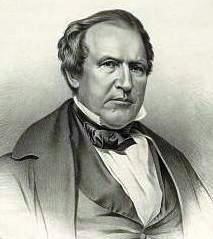Date(s) September 17–18, 1856 Venue Maryland Institute | City Baltimore, Maryland Chair Edward Bates | |
 | ||
Presidential nominee Millard Fillmore of New York Vice Presidential nominee Andrew Donelson of Tennessee | ||
The 1856 Whig National Convention was a quadrennial presidential nomination convention of the Whig Party. The convention was held at the 1851 landmark Maryland Institute for the Promotion of the Mechanic Arts over the old Centre ("Marsh") Market in Market Place (formerly Harrison Street) between East Baltimore Street and Water Street along South Gay Street and the west bank of the Jones Falls stream through downtown Baltimore, in Maryland on September 17 and September 18, 1856. Same site as the previous 1852 Convention. Former President Millard Fillmore was nominated as the party's candidate for President, four years after a failed bid to win the nomination in 1852. Andrew J. Donelson, nephew of the late President Andrew Jackson, was nominated as the party's candidate for Vice President. The convention was the last for the Whig party, which had floundered after losing a total of 37 seats in the Congress in the 1850 and 1852 elections. The Democratic candidates James Buchanan and John C. Breckinridge, won the 1856 presidential election.
Contents
Fall of the Whigs
The Whig party had been declining in power for some time before its last national convention in 1856. In the 1850 midterm elections, Democrats strengthened their majority as the Whigs lost 23 seats in the House and 2 seats in the Senate. In 1852, the Whigs lost another 14 House seats and one Senate seat. Furthermore, they lost the 1852 presidential election, their third loss in five campaigns.
A major reason for the Whig party's decline was a loss of its most influential leaders. Whig leaders from Southern slave states joined the Democratic party. Additionally, the Whigs' New York state convention in Syracuse voted to join with the newly formed Republican party.
On March 10, 1856, the Whig National Committee met and voted to reject the New York Whigs' merger with the Republican party. Whig leaders from Kentucky met and held their state convention in April. There they voted to call a national convention.
In the months leading up to the national convention, Whigs met in convention in several states to select which delegates would be sent to Baltimore in September. Delegates to these state conventions debated several options for the upcoming general election: the party could choose former President Millard Fillmore as its candidate, nominate another Whig, or endorse the Democratic candidate James Buchanan. As the state conventions met, Fillmore emerged as the clear choice.
American Party nomination
The American Party, formerly the Native American Party, was the vehicle of the Know Nothing movement. The American Party absorbed most of the former Whig Party in 1854, and by 1855 it had established itself as the chief opposition party to the Democrats. In the 82 races for the House of Representatives in 1854, the American Party ran 76 candidates, 35 of whom won. None of the six Independents or Whigs who ran in these races was elected. The party then succeeded in electing Nathaniel P. Banks as Speaker of the House in the 34th Congress.
The American National Convention was held in National Hall in Philadelphia, Pennsylvania, on February 22 to 25, 1856. Following the decision by party leaders in 1855 not to press the slavery issue, the convention had to decide how to deal with the Ohio chapter of the party, which was vocally anti-slavery. The convention closed the Ohio chapter and re-opened it under more moderate leadership. Delegates from Ohio, Pennsylvania, Illinois, Iowa, New England, and other northern states bolted when a resolution declaring that no candidate that was not in favor of prohibiting slavery north of the 36'30' parallel would be granted the nomination was voted down. This removed a greater part of the American Party's support in the North outside of New York, where the conservative faction of the Whig Party remained faithful. Former President Millard Fillmore was nominated for president with 179 votes out of the 234 votes cast. The convention chose Andrew Jackson Donelson of Tennessee for vice-president with 181 votes to 30 scattered votes and 24 abstentions.
A group of North American delegates called the North American Seceders withdrew from the convention and met separately. They objected to the attempt to work with the Republican Party. The Seceders held their own national convention on 6/16-17/1856. 19 delegates unanimously nominated Robert F. Stockton for president and Kenneth Raynor for vice-president. The Seceders' ticket later withdrew from the contest, with Stockton endorsing Millard Fillmore for the Presidency.
The Last Whig Convention
Twenty-six states out of thirty-one sent 150 delegates to the national convention in late September 1856. The convention met for only two days and on the second day (and only ballot) quickly nominated Fillmore for president, who had already been nominated for president by the Know Nothing party. Andrew Jackson Donelson was nominated for vice president.
Among the delegates to the convention was John Bell of Tennessee.
